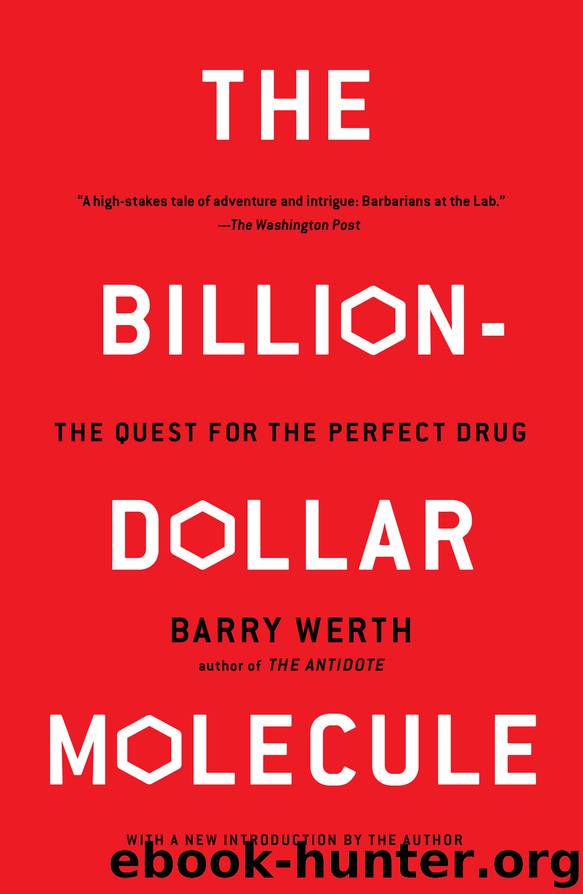The Billion-Dollar Molecule by Barry Werth

Author:Barry Werth
Language: eng
Format: epub
Publisher: Simon & Schuster
CHAPTER THIRTEEN
Scientifically and financially, Vertex has three modes: project, protoproject, and what Boger calls “preprotoproject.” Immunophilin research had been by necessity in full project mode from the minute Boger conceived it because it was all that he had. Its larger shortcomings—notably the question of whether Vertex had the right target—were blindly forgiven as Boger needed to identify quickly a field in which he could claim to have a lead. Businesswise, the strategy worked. Boger had been able to sell the project at a premium. Now, as he weighed the imperative of a second project, he knew it wouldn’t be nearly so easy.
“This is the most important decision we’ll make in the next twelve months,” he told the scientists. “If we blow the second program, it could be fatal.”
Prone to hyperbole, this time Boger wasn’t exaggerating. Industrywide, fewer than one in ten programs yields a drug: No company, no matter how smart, can survive on a single project. Worse for start-ups, they are often marginalized to the most speculative, high-risk areas of business and research or sandwiched into niches. Small, emerging drug companies are like first-time horse players with gravid ambitions and dire means: They can’t bet enough on favorites to win big so they try to parley intriguing long shots. Boger had wagered almost everything he had on immunophilins. With the race still on, the windows were now closing again. He needed to place a bet.
Vertex’s one protoproject—AIDS—had failed to move him. Navia’s “hallucination,” which started it, ended dismally, a bad trip. Two chemists, Roger Tung and Dave Deininger, spent four months making compounds based on his computer models only to find that they were dead—inactive—against HIV protease, the enzyme Navia predicted they would block. Meanwhile, a compound first made by the chemists to inhibit FKPB showed some inadvertent promise but not enough. Unimpressed, Boger had begun to think more about what HIV protease could do for Vertex than what Vertex could do to the enzyme. “We’re not going to do a smoke and mirrors project again; it won’t fly,” he told the scientists at a meeting in September. “But there’s the possibility that we could use HIV protease to field a larger aspartyl proteinase program. That makes it interesting.”
That Vertex might use AIDS as a stalking horse to raise money to bootstrap other projects struck several of the scientists as cynical and disingenuous. Boger had no such qualms. Science is rarely, if ever, linear, and information isn’t necessarily most useful in answering those questions that elicit it in the first place. Indeed, the brightest facet of the drug industry’s on-again, off-again optimism about making AIDS drugs was its recent successes with related systems. Renin, the protein-cleaving enzyme on which Boger had done his career-making work at Merck, was a perfect example. No renin blocker had ever become a drug despite a decade of intensive research efforts at Merck and elsewhere. But trying to inhibit renin had prepared the industry for HIV protease, which is strikingly similar.
Boger: “One of the
Download
This site does not store any files on its server. We only index and link to content provided by other sites. Please contact the content providers to delete copyright contents if any and email us, we'll remove relevant links or contents immediately.
| Administration & Medicine Economics | Allied Health Professions |
| Basic Sciences | Dentistry |
| History | Medical Informatics |
| Medicine | Nursing |
| Pharmacology | Psychology |
| Research | Veterinary Medicine |
The Poisoner's Handbook by Deborah Blum(2094)
Bottle of Lies by Katherine Eban(1764)
Mycelium Running: How Mushrooms Can Help Save the World by Paul Stamets(1645)
The Vaccine Race by Meredith Wadman(1630)
Missing Microbes by Martin Blaser(1558)
The Doors of Perception and Heaven and Hell by Aldous Huxley & Aldous Huxley(1551)
Pharmacy Practice and The Law by Richard Abood(1544)
Decisive by Chip Heath(1521)
28 Seconds by Michael Bryant(1490)
Steroids: History, Science, and Issues by Standora Joan E.; Bogomolnik Alex; Slugocki Malgorzata(1480)
McGraw-Hill Nurses Drug Handbook by Patricia Schull(1466)
The Doors of Perception: Heaven and Hell (thINKing Classics) by Aldous Huxley(1452)
Ganja Yoga by Dee Dussault(1429)
What's Making Our Children Sick? by Michelle Perro(1385)
Complete Guide to Prescription & Nonprescription Drugs 2014 by H. Winter Griffith(1333)
Stealing Fire: How Silicon Valley, the Navy SEALs, and Maverick Scientists Are Revolutionizing the Way We Live and Work by Steven Kotler & Jamie Wheal(1311)
Anatomy of an Epidemic by Robert Whitaker(1295)
Trip by Tao Lin(1266)
Cannabis for Chronic Pain by Rav Ivker(1202)
